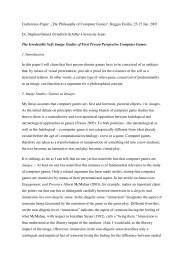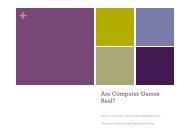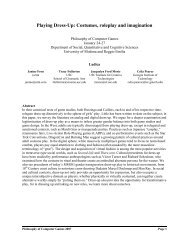Charles Sanders Peirce and the Mind-Body-World Relation
Charles Sanders Peirce and the Mind-Body-World Relation
Charles Sanders Peirce and the Mind-Body-World Relation
You also want an ePaper? Increase the reach of your titles
YUMPU automatically turns print PDFs into web optimized ePapers that Google loves.
structural relations in functional terms, as a kind of “technology of mind” 7 . Languageis able to facilitate an opportune <strong>and</strong> steady generation, enunciation <strong>and</strong> interpretationof linguistic (<strong>and</strong> o<strong>the</strong>r) signs in any kind of social or cultural context. Linguisticsigns contribute, in <strong>the</strong> context of a wider communicative community (whe<strong>the</strong>rspeakers or users of <strong>the</strong> language acknowledge <strong>the</strong> importance of <strong>the</strong> role of thiscommunity or not) <strong>the</strong> self-organisation of a sense of “self”, or “personality”, bothfrom <strong>the</strong> user’s own, <strong>and</strong> o<strong>the</strong>r’s point of view. However, in <strong>the</strong> final analysis, this“personality” is corporeally context-dependent, in <strong>the</strong> sense that it must be continuallymanifested, developed <strong>and</strong> maintained by <strong>the</strong> physiologically determined agility of<strong>the</strong> articulatory apparatus – of which <strong>the</strong> tongue is <strong>the</strong> most obvious organ (ormodule).Now it is clear that <strong>the</strong>re are o<strong>the</strong>r aspects to language <strong>and</strong> language use than speech –a considerable part of our everyday interpersonal communication depends veryheavily indeed on <strong>the</strong> unhindered exchange <strong>and</strong> interpretation of various kinds of nonverbalmessages, as <strong>the</strong> study of kinesics, proxemics, facial expression, gaze, eyemovements <strong>and</strong> gesture have clearly shown. The technology of writing represents <strong>the</strong>languages we use in ano<strong>the</strong>r medium, <strong>and</strong> with a type of grammatical organisationthat is different in a number for ways from that of spoken language (see Halliday1995).In a longer time-scale, our general behaviour in relation to o<strong>the</strong>r people <strong>and</strong> <strong>the</strong> worldin general, when seen in relation to what we say <strong>and</strong> do not say, also “counts” inmeaning-making terms. We tend to construe <strong>and</strong> evaluate o<strong>the</strong>r people’s“personalities” from moment to moment <strong>and</strong> from situation to situation on <strong>the</strong> basis ofall of <strong>the</strong>se things. So in this sense, merely considering <strong>the</strong> activity of <strong>the</strong> tongue as<strong>the</strong> seat of <strong>the</strong> “personality” is not enough. Speech, talk, dialogue or conversation is initself a multimodal 8 form of a much broader “genre” of communicative activity, oftenreferred to as communicative action 9 , <strong>and</strong> in this wider picture of things <strong>the</strong>re aremany, many externally visible aspects of <strong>the</strong> more general “articulatory system” tiedto language production <strong>and</strong> use that count at least as much as what our tongue isdoing, in order for successful communication to occur, <strong>and</strong> consequently too, for <strong>the</strong>construction of “personality”.And indeed, it is also <strong>the</strong> case that <strong>the</strong>re are languages where <strong>the</strong> activity of <strong>the</strong> tongueis of subsidiary importance, <strong>and</strong> where <strong>the</strong> whole articulatory apparatus of language is“externalised”, <strong>and</strong> where all <strong>the</strong> “internal” motions of this apparatus are consequentlyvisible to interlocutors <strong>and</strong> o<strong>the</strong>rs. Here I am thinking quite specifically of <strong>the</strong> signlanguages of deaf people, where phonological, morphological, syntactic <strong>and</strong> semanticproduction processes take place in what is generally known by sign language linguistsas “signing space”: a three-dimensional zone in front of <strong>the</strong> body largely defined by<strong>the</strong> specific range of motions which are possible for any given signer’s head, arms <strong>and</strong>h<strong>and</strong>s.As can be seen in Figure 1 below, signing space also includes a certain well-definednumber of articulation points or zones on <strong>the</strong> front of <strong>the</strong> body of <strong>the</strong> signer,7 The designation “technology of mind” was, as far as I am aware, coined by anthropologist Jack Goody inconnection with his considerations of individual <strong>and</strong> socio-cultural functional aspects of writing. See for exampleGoody 1987.8 The notion of multimodality has been delineated in different ways, According to Australian linguist Martin(2001), multimodality in communication involves verbiage, image(ry), sound <strong>and</strong> action. Social linguistics, heclaims, needs models of multimodality, coupled with those of multilinguality (encompassing language, dialect,register <strong>and</strong> code) <strong>and</strong> multifunctionality (encompassing ideational, interpersonal <strong>and</strong> textual meaning in language<strong>and</strong> text) to meet what he refers to as “<strong>the</strong> challenge of hybridity – <strong>the</strong> multi-voicing of our post-colonial world”(Martin 2001: 311). See also Martin 2000.9 See for example <strong>the</strong> Theory of Communicative Action of sociologist <strong>and</strong> philosopher Jürgen Habermas (1997)






